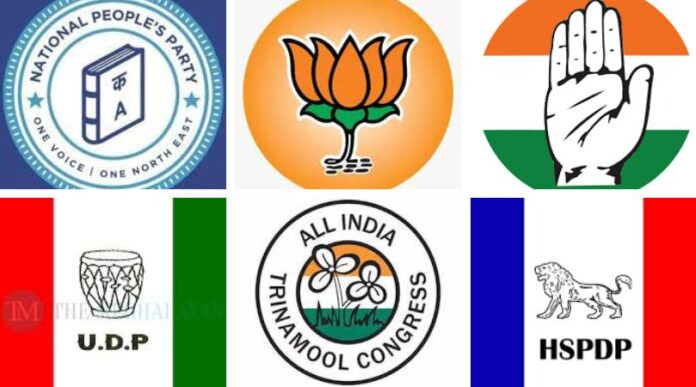SHILLONG:
With just hours left before the die is cast for the 11th Meghalaya Legislative Assembly with the election of new representatives, it wouldn’t be long before attention shifts to formation of government.
Exit polls prediction indicates a coalition government, though others may differ.
There is no denying that the moment the results are announced, horse-trading will follow, if it has not begun already.
No matter which party wins how many seats, Meghalaya will most likely see a hung assembly or fractured mandate yet again.
Coalition government has been synonymous with Meghalaya ever since 1978.
SINGLE PARTY-LED GOVERNMENT
In 1970, when Meghalaya was an autonomous state, the All Party Hill Leaders Conference (APHLC) with its nominated MLAs was in power.
After Meghalaya attained statehood in 1972, the first election saw APHLC win 32 seats, thus paving the way for the regional party to form a single party-led government with Capt. Williamson Sangma as chief minister, BB Lyngdoh as finance minister and RS Lyngdoh as Speaker.
The APHLC, with its popular ‘Rose’ symbol, could have won many more seats. But since there was already a “secret understanding” between the regional force and then Prime Minister Indira Gandhi before statehood, APHLC gave some seats to Congress, but the government was led solely by APHLC, with the Hill State People’s Democratic Party (HSPDP) in the opposition.
The APHLC government, with “tacit” support from Congress, ruled the state till October 1976. In the same year, the All India Congress session was held at Gauhati (now Guwahati) and subsequently, during the Mendipathar Conference, APHLC MLAs decided to merge with Congress except for four top leaders – BB Lyngdoh, PR Kyndiah, SDD Nicholas Roy and Darwin Diengdoh Pugh – and the party continued to live on. But considering its lesser number, Congress formed the government from 1976 till 1978.
PRECEDENT IS SET
In 1978, a precedent was set when the first coalition government was formed in Meghalaya – popularly known as the ‘3-flag regional party government’ – with APHLC, HSPDP and Public Demands Implementation Convention (PDIC) – and DD Pugh as chief minister.
But little did leaders and citizens know that this trend would continue decades later.
This government lasted only till May 1979. In 1979, APHLC (BB Lyngdoh) formed the government with Congress for two years each. BB Lyngdoh governed as the chief minister from 1979 till 1981 with Capt. Williamson Sangma as the chairman of the Meghalaya State Planning Board (MSPB) – a rank equivalent to that of the chief minister. From 1981 till 1983, the two leaders exchanged their roles – Sangma as chief minister and Lyngdoh as MSPB chairman.
SHORTEST COALITION GOVT
In the 1983 general election, Meghalaya witnessed an APHLC-HSPDP-PDIC government that lasted only 28 days; BB Lyngdoh was chief minister and EK Mawlong was speaker – and the jinx of unstable governments began.
The fall of the 3-flag regional front paved the way for Congress to form the government with splits in regional parties; Capt Williamson Sangma was the chief minister and EK Mawlong continued serving as the Speaker during Congress regime till 1988.
In 1983-84, the major regional parties tried unifying but were unsuccessful. The parliamentary elections of 1984 that was necessitated following the assassination of Indira Gandhi witnessed the first attempt of regional parties to work together in a bid to defeat the Congress.
Congress’ GG Swell went head on against Barrister Pakem, a candidate of the United Regional Front, who fought on a ‘2-leaf’ symbol. Swell defeated Pakem; talks for unity among regional parties continued but failed.
In 1987, the Hill People Union (HPU) with the ‘Rising Sun’ symbol was formed by defectors from the APHLC, HSPDP and PDIC.
However, APHLC and HSPDP were not dissolved since Hopingstone Lyngdoh and EK Mawlong (HSPDP) and Armison Marak (APHLC-A) chose to remain with their parent parties.
In the 1988 election, under the leadership of BB Lyngdoh, HPU won 19 seats that fell to 11 seats in 1993.
In 1997, its members joined with HSPDP and PDIC to form the United Democratic Party (UDP).
Interestingly, from 1972 till 1997, the only regional party that survived is the HSPDP. The other parties – APHLC, HPU and PDIC – died a natural death due to a merger that ultimately led to the formation of UDP.
In the following years, Khun Hynñiewtrep National Awakening Movement (KHNAM), under the leadership of former president of the Khasi Students’ Union (KSU) Paul Lyngdoh, came into the picture and won two seats in the 2003 election.
In 2021, another regional party – Voice of the People Party (VPP), under the leadership of former HSPDP president Ardent Miller Basaïawmoit – was formed.
VPP is contesting 18 seats in this election, and according to one prediction, might secure 1-3 seats.
For decades, since 1978, Meghalaya has never had a single party-led government and 2023 is unlikely to throw up one either.
Questions on instability will also be raised once a new government is formed. Unstable politics in Meghalaya is not new – the only stable government the state had was in 1972.
Of course, Mukul Sangma, who led the government (Meghalaya United Alliance MUA I and MUA II) from 2010 to 2018, and Conrad Sangma, who led the Meghalaya Democratic Alliance (MDA), completed their full terms as chief ministers, but one cannot deny the fact that several attempts were made, during Mukul and Conrad’s tenure, to shake things up and bring down their governments.
Given the political history of the state, it is most likely that coalition governments, coupled with instability (as witnessed in the past), will continue to haunt Meghalaya politics.


